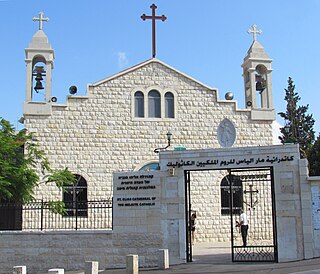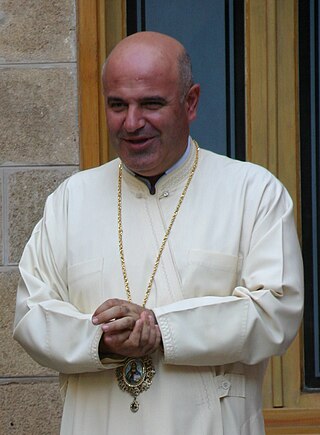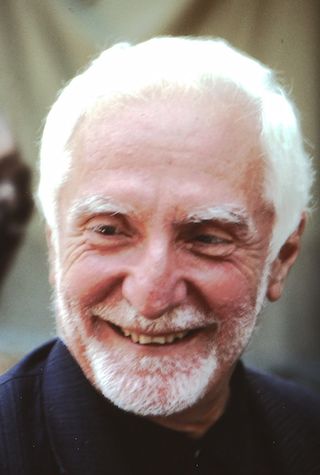Territory and statistics
The territory of the archeparchy includes Beirut, the capital of Lebanon, and its environs; much of Mount Lebanon governorate (to the north Antelias, Jounieh, and Byblos; to the east Baabda, Broumana, and Bikfaya) and south to part of Chouf District. [2] The archeparchy has an estimated population of 200,000 Melkite faithful in 2015. Its cathedral is dedicated to Saint Elias and its see is located in Beirut. It includes 114 priests, 83 men religious, 179 women religious, and 83 parishes. [3]
History
The Eparchy of Beirut is an ancient Byzantine one, elevated to the rank of archeparchy with the Council of Chalcedon in the fifth century.
The Greek Catholic Eparchy of Beirut was officially founded in 1724, after the Patriarch of Antioch was divided into two branches, the Greek Orthodox and Greek Catholic (or Melkite). [1]
In 1701, the Greek bishop of Beirut, Sylvester Dahan, had sent to Rome a profession of the Catholic faith, renewed in the following year. Those were the years when Catholicism obtained great progress in the ranks of the Greeks in the cities of the Lebanese coast, where more entrenched was the presence of Christians of the Byzantine Rite, and this mainly thanks to the missionary work of the Jesuits and the Capuchins.
Great impetus to the spread of Catholicism in Beirut and in the surrounding areas was the founding of the Chouerites, that at the beginning of their history had most of the monasteries in Beirutian territory. Belonged to this Order was Athanasios Dahan, Catholic Bishop of Beirut and the future patriarch, who first organized the new Catholic diocese.
With his successor Basilios Jelghaf the cathedral was built on land owned by the Chouerites. A dispute between the Order and the Bishop Youssef Sarrouf about the real estate of the cathedral forced the Holy See to intervene to give reason to the Bishop (1784).
The bishop Agapios Riashi [4] was one of the most vocal opponents of the introduction of the Gregorian calendar desired by Patriarch Maximos III Mazloum. Riashi was responsible for the reconstruction of the cathedral in a more impressive and rich decorations including an iconostasis in marble. This church was demolished in the twentieth century for urban needs.
On the death of Agapios Riashi in 1878 the Melkite community is divided on the choice of his successor. The Chouerites, which so far had given all the bishops of Beirut, and they considered the seat as their fiefdom, lived a difficult time and had no monks prepared for the episcopate. Patriarch Gregory II Youssef was Damascene and Melkite Beirut feared that ended up imposing a native bishop of Damascus. Eventually prevailed to the Holy See, when Pope Leo XIII with his Papal brief Occasione electionis on August 16, 1881, chose Meletios Fakak transferring him from his see in Zahleh and appointing to new Melkite Greek Catholic Archeparchy of Beirut and Byblos. The former Eparchy of Beirut was elevated to the rank of the Archeparchy, uniting it to the seat of Byblos, formerly administered by the bishops of Beirut since 1802. Byblos corresponds to the ancient Byzantine Diocese of Byblos, mentioned in the fourth century. Fakak made his solemn entry only September 30, 1882.

The Melkite Greek Catholic Church, or Melkite Byzantine Catholic Church, is an Eastern Catholic church in full communion with the Holy See as part of the worldwide Catholic Church. Its chief pastor is Patriarch Youssef Absi, headquartered at the Cathedral of Our Lady of the Dormition in Damascus, Syria. The Melkites, who are Byzantine Rite Catholics, trace their history to the early Christians of Antioch, formerly part of Syria and now in Turkey, of the 1st century AD, where Christianity was introduced by Saint Peter.

The Melkite Catholic Patriarchate of Antioch is the only actual residential Patriarchate of the Melkite Greek Catholic Church. It was formed in 1724 when a portion of the Orthodox Church of Antioch went into communion with Rome, becoming an Eastern Catholic Church, while the rest of the ancient Patriarchate continues in full communion with the rest of the Eastern Orthodox Church.
Melkite Greek Catholic Archeparchy of Zahle and Forzol is a diocese of the Melkite Greek Catholic Church.
Ignatius IV (Youssef) Sarrouf was Patriarch of the Melkite Greek Catholic Church in 1812. He is remembered for both his patriarchate, and for having been, as metropolitan of Beirut, a leading figure in the early history of the Melkite Church.

Melkite Greek Catholic Archeparchy of Akka is an Eastern Catholic diocese of Melkite Greek Catholic Church, directly subject to the Melkite Catholic Patriarchate of Antioch. Its Cathedral episcopal see is St. Elijah Greek-Melkite Cathedral, in Haifa.
George Riashi was the Greek Melkite Catholic bishop of Melkite Greek Catholic Archeparchy of Tripoli and all North Lebanon.

Georges Bacouni, also transliterated Bakhouni or Bakouny, is the Archbishop of the Melkite Greek Catholic Archeparchy of Beirut and Byblos
Joseph Kallas, SMSP is Emeritus Melkite Archbishop of the Melkite Greek Catholic Archeparchy of Beirut and Byblos.
Joseph Gébara is a Lebanese Catholic archeparch of the Byzantine Rite, and current Archeparch of the Melkite Greek Catholic Archeparchy of Petra and Philadelphia in Amman.

Grégoire Haddad in Arabic was Archeparch of the Melkite Greek Catholic Archeparchy of Beirut and Byblos from 1968 to 1975. He was known as the "Red Bishop of Beirut" promoting a secular "social movement" and a platform of rapprochement between Muslims and Christians with the onslaught of the Lebanese Civil War. He reinforced his controversial viewpoints through further secular movements and through Afaq magazine, which he founded. In 1975 under pressure from the Holy See, he resigned from active religious duty. Since his resignation, he became an emeritus archbishop without holding an actual diocese in Lebanon.
Habib Bacha, SMSP was Melkite Archbishop of the Melkite Greek Catholic Archeparchy of Beirut and Byblos.
Melkite Greek Catholic Archeparchy of Baalbek is a diocese of the Catholic Church immediately subject to the Patriarchate of Antioch of the Melkites. It is currently governed by Archbishop Elias Rahal.
Melkite Greek Catholic Archeparchy of Baniyas is a diocese of the Melkite Greek Catholic Church suffragan of the Melkite Greek Catholic Archeparchy of Tyre. In 2009 there were 2,500 baptized. It is currently governed by Archeparch Georges Nicholas Haddad, SMSP. The Archeparchy is named after the city of Baniyas.
Melkite Greek Catholic Archeparchy of Bosra and Hauran is an archeparchy of the Melkite Greek Catholic Church with its territory located in Syria. It is currently governed by Archeparch Nicolas Antiba, BA.

Melkite Greek Catholic Archeparchy of Tyre is a metropolitan see of the Melkite Greek Catholic Church. In 2009 there were 3,100 baptized. It is currently governed by an Apostolic Administrator, Archbishop Elie Bechara Haddad, B.S., because of the 31 January 2021 removal of Archeparch Michael Abrass, BA.
Jean Assaad Haddad was a Lebanese Melkite hierarch, who served as an archbishop of the Melkite Greek Catholic Archeparchy of Tyre in Lebanon.
Jean Bassoul, BS, also John Bassoul, was an archbishop of the Melkite Greek Catholic Archeparchy of Zahle and Forzol.
Jean Mansour, SMSP was Bishop and administrator in the Melkite Patriarchate of Antioch.
Saint Elias Greek Catholic Cathedral is a Melkite Greek Catholic cathedral located in downtown Beirut, Lebanon, dedicated to Saint Elias, completely restored after the Lebanese Civil War (1975–1990) on previous constructions dating to a Choueirite convent from the 19th century. Its plan followed the Byzantine style.
This page is based on this
Wikipedia article Text is available under the
CC BY-SA 4.0 license; additional terms may apply.
Images, videos and audio are available under their respective licenses.















